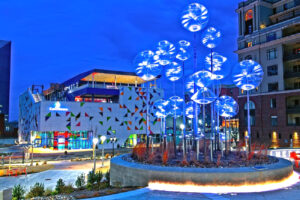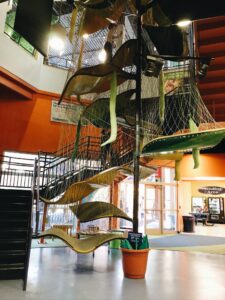Kaleideum's History
 Kaleideum was created from the July 2016 merger of the Children’s Museum of Winston-Salem and SciWorks, the Science Center and Environmental Park of Forsyth County. The museum operated in two locations — Kaleideum Downtown (formerly The Children’s Museum of Winston-Salem) and Kaleideum (formerly SciWorks) — until it opened in a new, five story building in downtown Winston-Salem in February 2024.
Kaleideum was created from the July 2016 merger of the Children’s Museum of Winston-Salem and SciWorks, the Science Center and Environmental Park of Forsyth County. The museum operated in two locations — Kaleideum Downtown (formerly The Children’s Museum of Winston-Salem) and Kaleideum (formerly SciWorks) — until it opened in a new, five story building in downtown Winston-Salem in February 2024.
Nature Science Center | SciWorks |Kaleideum North
In 1962, four women, on behalf of the Junior League of Winston-Salem, introduced a new idea for a nature science center that would become a permanent part of the educational and recreational landscape for Winston-Salem. By January 1964, the decision was made to locate the center in the barn at Reynolda Estate, which was graciously made available by the Mary Reynolds Babcock Foundation. Through the cooperation of Wake Forest College, the 100 acres surrounding the building were also made available for outdoor study and conservation. Plans for the center included educational programs in the natural and physical sciences, displays, dramas, field trips, nature walks, and a small planetarium in the barn’s silo. Co-sponsored by the Recreation Department of the City of Winston-Salem, the Winston-Salem Foundation, the Mary Reynolds Babcock Foundation, and the Junior League of Winston-Salem, the Nature Science Center officially opened its doors on December 12, 1964, opening the door for generations of Piedmont Triad residents and visitors to experience scientific inquiry through informal, hands-on, experiential learning. During October of the following year, there was a formal ribbon-cutting and dedication.
 In 1972, the Nature Science Center moved to its second location at 400 West Hanes Mill Road, a campus that originally housed the Forsyth County Home and Hospital, the precursor to Forsyth Medical Center. In 1992, the Nature Science Center closed and underwent a major renovation, re-opening under the name SciWorks. The building had 30,000 square feet of exhibit space, a 15-acre environmental park, and a planetarium. Exhibit galleries covered a wide range of topics such as North Carolina geography and geology, the human body, physics (featuring a Foucault pendulum, sound, and technology. In addition, there was a traveling exhibit gallery that featured both nationally touring exhibits and exhibits created in-house. The BioWorks exhibit, which focused on both local and exotic animals, was renovated in 2010. The environmental park featured white-tailed deer; river otters; a barnyard with donkeys, sheep, and cows; gardens of native vegetation; and outdoor exhibits on sound and fluids. After the 2016 merger with the Children’s Museum of Winston-Salem, the name was changed from SciWorks to Kaleideum North.
In 1972, the Nature Science Center moved to its second location at 400 West Hanes Mill Road, a campus that originally housed the Forsyth County Home and Hospital, the precursor to Forsyth Medical Center. In 1992, the Nature Science Center closed and underwent a major renovation, re-opening under the name SciWorks. The building had 30,000 square feet of exhibit space, a 15-acre environmental park, and a planetarium. Exhibit galleries covered a wide range of topics such as North Carolina geography and geology, the human body, physics (featuring a Foucault pendulum, sound, and technology. In addition, there was a traveling exhibit gallery that featured both nationally touring exhibits and exhibits created in-house. The BioWorks exhibit, which focused on both local and exotic animals, was renovated in 2010. The environmental park featured white-tailed deer; river otters; a barnyard with donkeys, sheep, and cows; gardens of native vegetation; and outdoor exhibits on sound and fluids. After the 2016 merger with the Children’s Museum of Winston-Salem, the name was changed from SciWorks to Kaleideum North.
Throughout the museum’s location on Hanes Mill Road were painted ceramic tiles created by children and adults in 1993 and 1994 depicting science, astronomy, art, footprints, and many other imaginative subjects. The button below will take you to this digital representation of the children who grew up visiting the museum
Children's Museum of Winston-Salem | Kaleideum Downtown
The Children’s Museum of Winston-Salem, later renamed to Kaleideum Downtown after the merger, was originally located at 390 South Liberty Street in Winston-Salem. The museum was created by the Junior League of Winston-Salem as a gift to the city to celebrate the league’s 75th anniversary. The museum opened its doors during November 2004 as a safe place for young children and their families to learn and play together. Designed with a literature-based theme, the museum focused on experiential learning and the educational benefits of play through literature, storytelling, and the arts, while offering birthday parties, summer camps, field trips, workshops, storytime programming, theatre performances, and special community events. The Junior League pledged that 10 percent of its active members would volunteer at the museum until at least 2020.
In 2011, the Children’s Museum of Winston-Salem was honored to be awarded a $150,000 grant from the Institute of Museum and Library Services (IMLS)  Museums for America program. Museums for America is the nation’s largest federal funding program for museums. Reviewed by panels of professional peers, these grants are highly-competitive. The Museum’s grant funded a new interactive playscape – Kaleidoscape – and six additional, outdoor, participatory art installations.
Museums for America program. Museums for America is the nation’s largest federal funding program for museums. Reviewed by panels of professional peers, these grants are highly-competitive. The Museum’s grant funded a new interactive playscape – Kaleidoscape – and six additional, outdoor, participatory art installations.
Kaleideum Downtown featured many permanent and rotating exhibits including Kaleidoscape, a crocheted climbing structure by fiber artist Toshiko MacAdam; the Beanstalk, a multi-level climbing structures by playground designer Tom Luckey; “The Enchanted Forest”, an imaginative play area with a folklore theme; The Amazing Library for young readers; the Food Lion Supermarket, a child-sized supermarket area; Amazing Airways, a series of air tubes that are designed to allow children to test hypotheses about air flow; the The Prop Shop, a recreated backstage theater that providesd craft materials and suggested art activities; and the Krispy Kreme Doughnut Factory, an imaginative doughnut assembly line and delivery truck.
Kaleideum
 The Children’s Museum and SciWorks began talks of a possible collaboration in early 2015. On July 1, 2016, the two museums officially merged with a mission of “Inspiring wonder, curiosity, and lifelong learning in our children and community through interactive play and discovery.” The merged organization announced its new name — Kaleideum, a combination of kaleidoscope and museum — on February 7, 2017, as well as its intention to move to a new location in downtown Winston-Salem.
The Children’s Museum and SciWorks began talks of a possible collaboration in early 2015. On July 1, 2016, the two museums officially merged with a mission of “Inspiring wonder, curiosity, and lifelong learning in our children and community through interactive play and discovery.” The merged organization announced its new name — Kaleideum, a combination of kaleidoscope and museum — on February 7, 2017, as well as its intention to move to a new location in downtown Winston-Salem.
Kaleideum announced on July 6, 2017, that Stitch Design Shop and Gensler would be the architectural firms for the new building, which was designed to reflect the idea of experiencing various perspectives and inspired by geometric shapes captured in a kaleidoscope. The Forsyth County Board of Commissioners funded $30.5 million of the project, the State of North Carolina provided $3.8 million through a budget appropriation, and Kaleideum funded the new exhibits through its “All In” Capital Campaign. The City of Winston-Salem provided $2 million for the development of Liberty Plaza, which is adjacent to the museum.
Kaleideum held a ceremonial ribbon cutting attended by the Forsyth County Commissioners, community leaders, Kaleideum staff, and other invited guests on February 15, 2024. On February 17, 2024, the museum held its Grant Opening at the new location in at 120 West 3rd Street in the heart of downtown Winston-Salem. The reimagined Kaleideum has four floors of permanent exhibitions that fuse science, technology, engineering, arts, and mathematics (STEAM) disciplines, including:
- By Design: Visitors can construct a building, craft pottery, model furniture, code a dance routine, or design a tattoo.
- In Motion: Designed around physics principles, families can engineer a roller coaster, capture kinetic movement, or build a race car.
- Digital Dome: The Digital Dome allows visitors travel through space, experience a laser light show or dive into an immersive movie.
- Our Nature: Families can investigate the constant change and surprising connections among life on Earth by exploring topography, checking out feathers and scales, or pretending you’re a wildlife veterinarian.
- Storytelling: Interactive experiences with animation, shadow puppets, sound effects, and phonetics.
- Wonders of Water: Experiences with water in all its wonderful forms by controlling a waterfall, sculpting an ice block and playing with light in a tunnel of fog.
- Little Learners: A cozy play-space for babies, crawlers, new walkers, and their caregivers full of natural light and soft surfaces.
- Try It! Studio: This maker space and art studio has activities such as painting, construction, robotics, and more.
- Rooftop Adventure: a large multi-level outdoor playground that spans the rooftop with skyline views of Downtown Winston-Salem.
In addition, the museum has a Feature Exhibition Gallery and rotates traveling or in-house exhibitions three times each year; pop up exhibits such as Backyard Block Party; and Learning Labs for field trips, Camp Kaleideum, and birthday parties.
